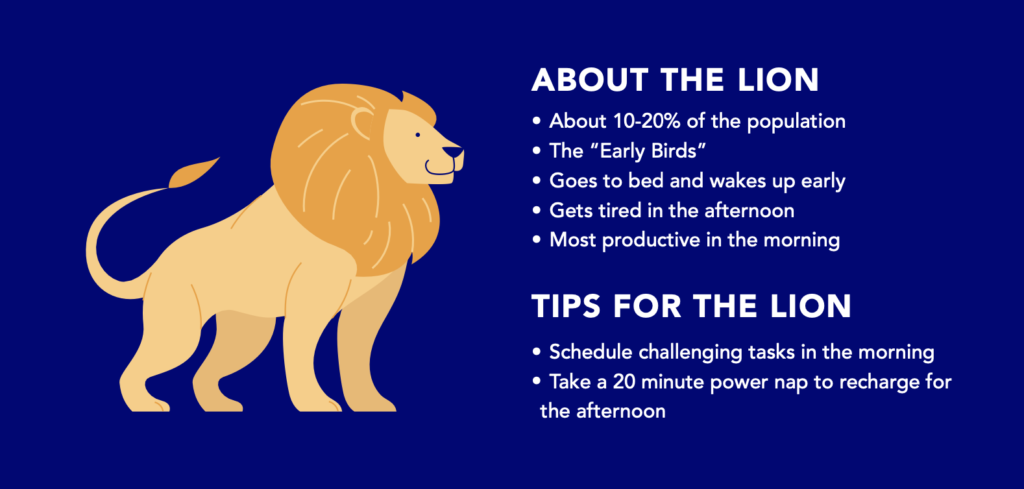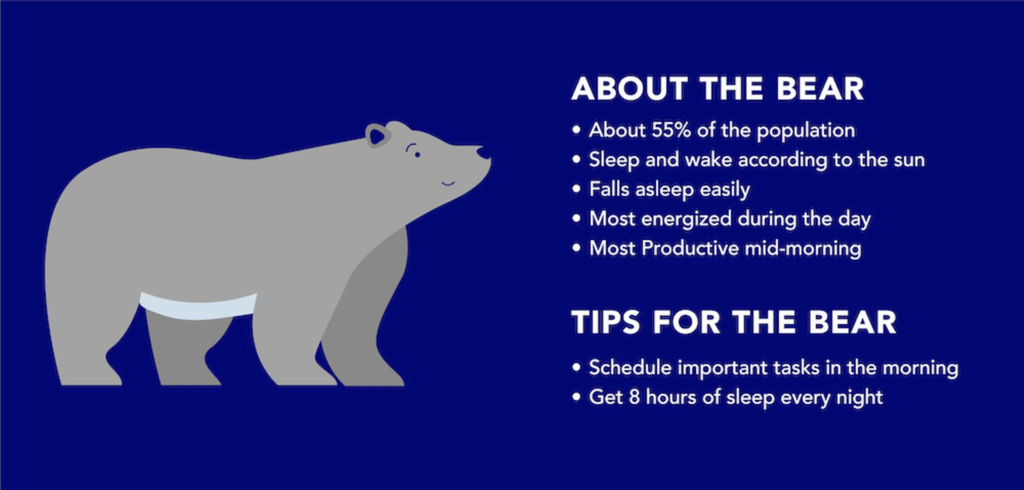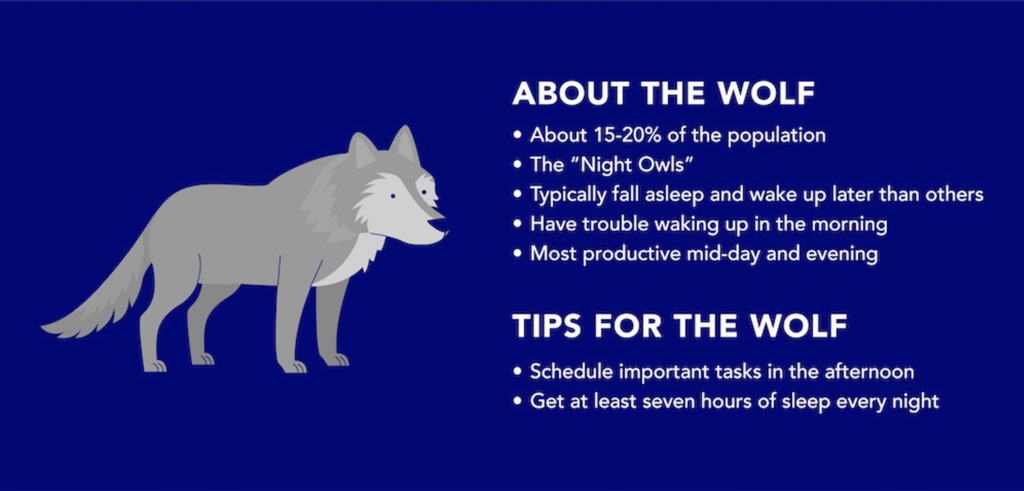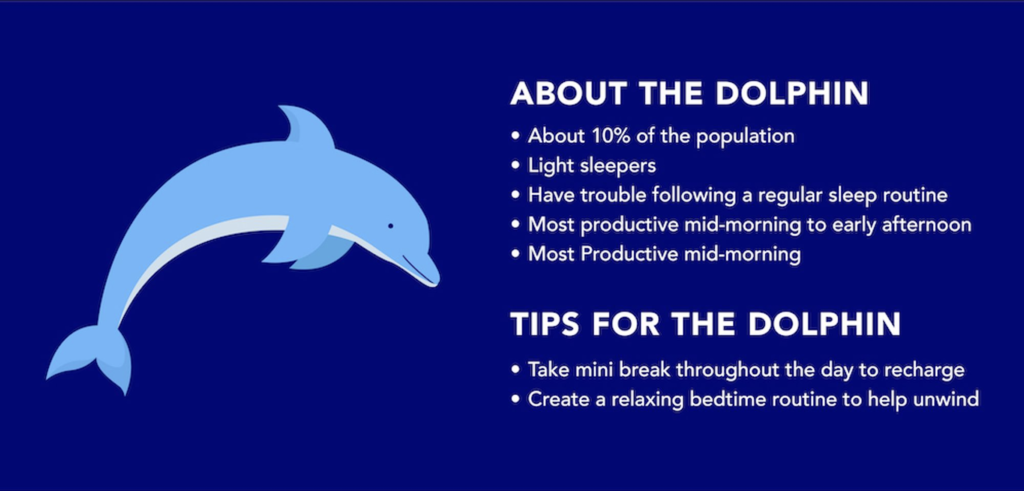The early bird gets the worm — probably because they’re up bright and early every day, ready to attend to any business at hand. And in stark contrast to those early birds (or “morning larks”), owls only seem to come alive when the sun goes down, ready to stay up into the wee hours. While we’re obviously talking about the sleep and waking habits of our friends in the animal kingdom, we can find early birds and (night) owls among humans, too — in the form of chronotypes.
If you’ve ever read anything about sleep chronotypes, or circadian typology, you know that morning larks and night owls dominate the discussion, but recent research has shown that limiting chronotypes to two categories is a gross oversimplification. A deeper dive into the complex world of chronobiology reveals that there are four sleep chronotypes: lions, bears, wolves, and dolphins — which one are you?
What Is A Chronotype?
A chronotype is your body’s natural tendency to go to sleep and wake up at certain times. Chronotypes, whether late or early, usually follow the timing of our natural circadian rhythms. Early chronotypes prefer to wake up before sunrise and take advantage of their peak performance window before noon. Late chronotypes prefer to go to bed closer to midnight, wake up later in the morning, and tackle their to-do lists in the evening hours.
While most people understand the basic difference between early birds and night owls, research has recently revealed a few more pieces of the chronotype puzzle. In addition to definite morning chronotypes and definite evening chronotypes, we now know that there are moderate morning types and moderate evening types.
There are many different chronotypes out there — like the lark, hummingbird, and more — but the four that get the most attention are the lion chronotype, wolf chronotype, bear chronotype, and dolphin chronotype, which were introduced by Dr. Michael Breus, PhD, in 2016 — but more on those later.
Not sure what chronotype you are? Take our quick chronotype quiz to find out!
What Determines Your Chronotype?
Getting back to the science of chronobiology, chronotypes vary from person to person, and while it’s encoded in your DNA at birth, chronotypes are dynamic. Age, genetics, gender, and zeitgebers (environmental cues such as light, diet, and exercise that regulate your circadian rhythm) may all play a role in your chronotype throughout your life.
For starters, everyone has an inherent chronotype, but research shows that chronotypes change with age. Typically, chronotypes tend to shift to the later groups — think owls — during adolescence, before making a pivot and shifting earlier — like larks — after age 19.
Men often have later chronotypes than women, and twin and family studies show that chronotypes may be up to 50 percent heritable. And, if you know anything about sleep, then you know that your exposure to light, your level of physical activity, and your diet (including caffeine and alcohol consumption) all have a direct correlation to sleep duration, sleep onset, and therefore, your chronotype.
The Lion Chronotype

The lion chronotypes are the early risers of the world. These folks wake up early in the morning, brimming with vim and vigor to start their day. Lions are most productive in the morning hours before lunch, but as the hours tick by, they progressively lose steam. A midday power nap may help them recharge enough to check a few more boxes off their to-do list, and as you might have guessed, they’re usually not too keen on a packed social calendar during the evening hours.
Typically, lion characteristics are as follows:
- Early risers
- Pragmatic
- Goal oriented
- Optimistic
- Charismatic
The ideal daily schedule for the lion should look like:
- Wake up: Lion chronotypes are early risers, usually waking somewhere around 5:30 – 6:00 a.m.
- 8 a.m. – 12 p.m.: Lion chronotypes are most productive in the morning up until around lunchtime, when their roaring energy may begin to wane. From 8 a.m. – 12 p.m., they’re busily working on getting the lion’s share of their work done (sorry we couldn’t resist).
- 12 p.m. – 3 p.m.: By this time, lions have expended most of their energy, getting things checked off on their to-do list, so they’re likely running low on energy and motivation. An afternoon nap is pretty alluring to them right about now.
- 3 p.m. – 6 p.m.: Once they’ve regrouped with a nap, lion chronotypes will capitalize on that second wind and finish their workday strong.
- 6 p.m. – 9 p.m.: Lions are usually spent by the early evening hours. A good dinner and an evening of relaxation are their favorite rewards.
- Sleep: Lion chronotypes like to be in bed between 9-10 p.m. This ensures a full 8 – 9 hours of shut-eye, so they can wake before the alarm and get to work.
Famous lions include Tim Cook, Richard Branson, Benjamin Franklin, and Ernest Hemingway.
The Bear Chronotype

Bear chronotypes tend to follow the sun for their sleep and wake cycle. Bears make it a point to get 8 hours of sleep per night, and they don’t usually have any trouble falling asleep at night or waking up in the morning. Like lions, bears are most productive before noon and are prone to palpable dips in energy and poor focus after lunch. Bears and people run on similar schedules; waking with the sun and sleeping with the moon, it’s estimated that about 55 percent of people are bear chronotypes.
Typically, the characteristics of a bear are:
- Extroverted
- Social
- Cautious
The ideal daily schedule for the bear should look like:
- Wake up: Bears may not wake quite as early as their lion counterparts, but they’re still early risers, usually somewhere around 7 a.m. – 8 a.m.
- 10 a.m. – 2 p.m.: From midmorning to noon, bears can be found focused and working hard.
- 3 p.m. – 6 p.m.: Bears typically experience dips in their energy after lunch, so workflow often slows down during this time. This time should be reserved for lighter tasks.
- 6 p.m. – 9 p.m.: From 6:00 to 9:00 p.m., bear chronotypes are usually happiest sinking into their bedtime routines.
- Sleep: A full 8 hours of sleep is non-negotiable for bear chronotypes, so it’s usually lights out at 11 p.m.
Famous bears include Stephen King and Oprah Winfrey.
The Wolf Chronotype

Also known as the “night owl,” the wolf chronotypes are usually the most productive under cover of night. Wolves typically go to sleep late, and, as a result, they wake later in the morning. Wolf chronotypes usually take a while to get into the swing of things after waking, and the two most productive times for them are somewhere around noon and in the late evening. The secret sauce for wolves is to schedule lighter tasks for the morning and reserve more complex tasks for the evening hours.
The characteristics of a wolf are as follows:
- Creative
- Impulsive
- Daring
- Shrewd
The ideal daily schedule for the wolf should look like:
- Wake up: Wolves typically emerge from their den somewhere between 7:30 to 9:00 am.
- 10 a.m. – 12 p.m.: Wolves don’t usually get into the swing of things immediately after waking, so the period between 10:00 a.m. to 12:00 p.m. should probably be reserved for lighter, less important tasks.
- 12 p.m. – 3 p.m.: Two to three hours after lunch is peak performance time for wolf chronotypes. During this block on their calendar, wolf chronotypes can be found with their head down and hard at work as they tangle with the more difficult tasks of their day.
- 3 p.m. – 5 p.m.: Wolves don’t quit before quitting time. But while they’re still on the clock, they’re probably not getting after it like they did a few hours ago. Wolves are more likely to use the window between 3:00 p.m. and 5:00 p.m. to tick off the lighter tasks on their to-do list and maybe do a little inbox management.
- 5 p.m. – 9 p.m.: Wolf chronotypes like to lean into their creativity and doing so after work to unwind before bed sounds just about right.
- 9 p.m. – 12 a.m.: Wolves often reserve a few hours before their midnight bedtime to enjoy a prolonged bedtime routine.
- Sleep: For this late chronotype, bedtime is usually somewhere around midnight. With wake-up times starting at 7:30 am, wolves can easily get their full 8 hours — maybe more.
Famous wolves include Winston Churchill, Bob Dylan, Barack Obama, and John Travolta.
The Dolphin Chronotype

As the insomniacs of the group, dolphin chronotypes often have difficulty falling asleep and staying asleep. Moreover, they are easily awakened by noise and light. As a result of their wildly irregular sleep schedule, dolphins don’t typically get their required amount of sleep; they’re often tired throughout the day and tend to have a hard time waking up. Dolphins should schedule their most important tasks during the mid-morning to early afternoon window, as this is their most productive time. This chronotype should also consider breaks, small snacks, and short walks to better manage their ever-waning energy.
The characteristics of a dolphin are as follows:
- Introverted
- Cautious
- Intelligent
- Neurotic
The ideal daily schedule for the dolphin should look like:
- Wake up: Not to be confused with lions, dolphins usually wake up somewhere between 6:30–7:30 am.
- 8 a.m. – 10 p.m.: As they shake off a little sleep inertia, dolphin chronotypes are more likely to engage in lighter tasks through mid-morning.
- 10 p.m. – 12 p.m.: From mid-morning through lunchtime, dolphins have a brief but productive window to tackle their most pressing tasks and difficult projects.
- 12 p.m. – 4 p.m.: As lunch hour approaches, Dolphins are either running on empty or coming pretty close. Their time after lunch is best reserved for circling back to light work, small tasks, and other quick hits on their calendar.
- 4 p.m. – 10 p.m.: After-work hours for dolphins are best spent relaxing and unwinding.
- Sleep: Dolphins are notoriously troubled sleepers. So bedtime, whether they like it or not, is somewhere around midnight. On a good night, dolphins may even be able to meet their sleep requirements.
Famous dolphins include Jennifer Aniston, Rihanna, and Vincent Van Gogh.
What Is My Chronotype?
Chronotypes don’t determine or influence how much sleep we need, but they can give you some insight into the best timing for your sleep and wake schedules. By understanding your chronotype, you can improve your sleep, maximize your productivity, and live your best life.
If you’re not sure what chronotype you are, a chronotype quiz can be incredibly helpful. And even if you think you know your chronotype, give it a go anyway — the results may surprise you.
Circadian Rhythm vs. Chronotype
Your circadian rhythm is your body’s 24-hour internal clock that controls critical biological processes, like your sleep-wake cycle, temperature fluctuations, and hormone production. Chronotypes don’t have a direct effect on any of the biological processes listed above, but they can affect the timing of those processes. Those with an early chronotype will have a circadian rhythm that skews earlier, while those with a later chronotype will have a circadian rhythm that skews later.
Sleep Tips for All Chronotypes
Sleep hygiene doesn’t change based on your chronotype. Whether you’re a lion, a bear, a wolf, or a dolphin, good sleep habits are key to a good night’s sleep. In addition to maintaining a consistent sleep schedule, getting out into the sun, exercising, and keeping your sleep environment cool, quiet, and dark, listening to what your body is telling you is incredibly important. If your body is telling you to go to sleep at 9 p.m., then do it. If it feels better to go to sleep at midnight and wake later in the morning (life permitting, of course), then do that.
Beyond paying attention to sleep and wake signals, think about when you’re most focused, energized, and attentive, and plan your daily tasks accordingly. These factors are linked to your chronotype, and shuffling your schedule to match your cognition and energy levels could prove to be a winning move.
FAQ
Can you change your chronotype?
While you can’t do anything to proactively change your chronotype, research shows that chronotypes change with age. Typically chronotypes tend to shift later during adolescence, before making a pivot and shifting earlier after age 19.
Can you have multiple chronotypes?
You can have multiple chronotypes throughout your lifetime, but only one chronotype at a time.
Last Word From Sleepopolis
Chronotypes are your body’s natural preference to sleep and wake at a certain time. While most resources limit the discussion to early and late chronotypes — or larks and owls, new research shows that there are actually four chronotypes. Ultimately, knowing whether you are a lion, a bear, a wolf, or a dolphin could be the key to improving your sleep and boosting your productivity.


























